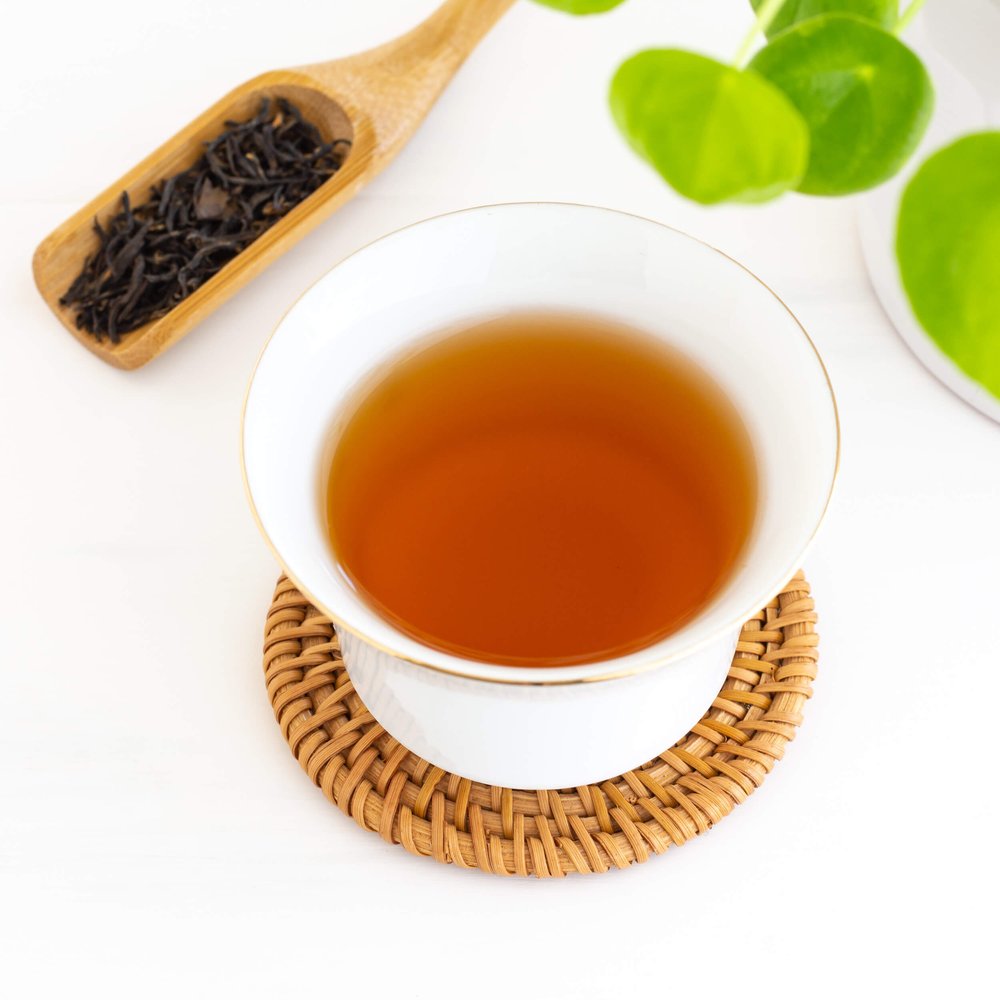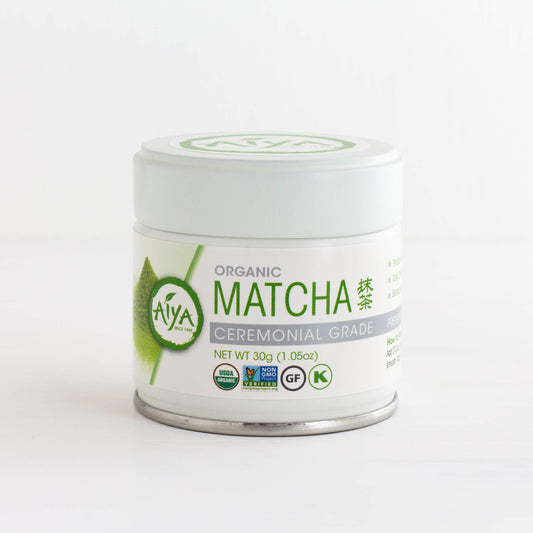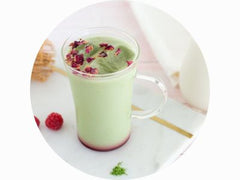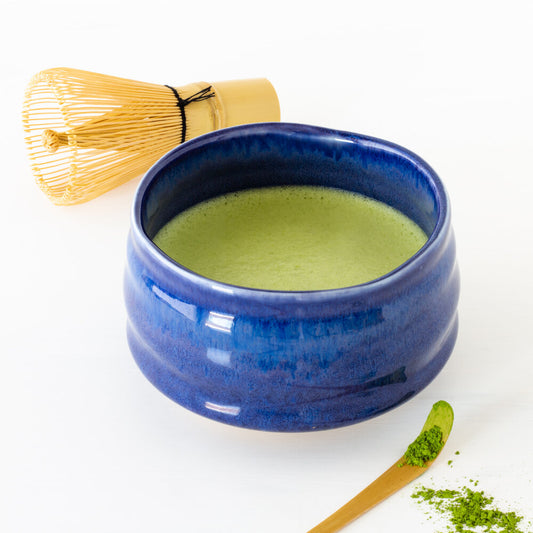What is matcha?
Matcha is a fine powder made from green tea leaves. It has a bright, emerald green color and a rich, vegetal taste. The tea plants used to make matcha are shaded for the last few weeks leading up to the harvest, which results in a dark green tea leaf that contains higher levels of chlorophyll, caffeine, and l-theanine. These tea leaves are also used to produce specialty Japanese green teas like Gyokuro and Kabusecha. After the tea leaves are harvested, they are steamed in order to halt the oxidation process. They are then stone-ground into a fine powder and packaged for sale.
Powdered green tea was first produced in China during the Tang Dynasty. In the 12th century, Chinese monks brought both Buddhism and matcha to Japan. The ritualized use of matcha by Japanese monks grew quickly, and by the 15th century, its popularity had spread to Japan’s upper classes. Over centuries, an intricate tea ceremony surrounding matcha was developed. Today, matcha is primarily associated with Japan, and has a rich history and cultural significance within the country.
What is ceremonial grade matcha?
Ceremonial grade matcha is a type of matcha that is designed to be used in a traditional Japanese tea ceremony. Ceremonial grade matcha is the highest quality grade of matcha. It tends to be slightly more subtle and nuanced than culinary grade matcha, and should be consumed on its own rather than added to lattes and other confections.
How to prepare ceremonial grade matcha
Matcha is traditionally prepared using a whisk, scoop, sifter, matcha bowl, and hot water heated to approximately 175 degrees. First, scoop the matcha powder into a sifter (we recommend about two scoops, or one teaspoon, of matcha powder per bowl.)
Sift the powder into the bowl, then add a small amount of hot water and whisk until smooth. Then add up to 6 ounces of water, and whisk until frothy. Preparing matcha is largely a matter of personal taste, so feel free to play around with these ratios to figure out what works best for you!
New to matcha and not sure where to begin? Our matcha starter kit contains everything you need to make matcha from the comfort of your kitchen.
Shop Ceremonial Grade Matcha >>>
What is culinary grade matcha?
Culinary grade matcha is a slightly lower grade of matcha than ceremonial grade matcha. It is usually less expensive, and is designed to be added to lattes, smoothies, baked goods, and other recipes. Culinary grade matcha tends to have a bolder, less nuanced flavor designed to stand up to other ingredients.
How to use culinary grade matcha
The sky’s the limit when it comes to culinary grade matcha! Many people use culinary grade matcha to make tea lattes. You can do this by whisking together matcha powder, steamed milk, and a sweetener of your choice, then topping with frothed milk for a creamy, sweet latte that’s full of flavor. Matcha can also be used in many different recipes, from smoothies to baked goods and more.
Shop Culinary Grade Matcha >>>
What’s the difference between green tea and matcha?
While green tea and matcha share many similarities, there are some important differences between these two types of tea. These include:
- Country of origin - Matcha is produced primarily in Japan, and is a significant part of Japanese culture and cuisine. Green tea is grown in China, Japan, and other Asian countries like Vietnam.
- Processing method - Green tea is either steamed or pan-fired after harvest in order to halt oxidation. Japanese green teas tend to be steamed, while Chinese green teas tend to be pan-fired. The tea leaves are then shaped, dried, and packaged. Matcha has many of the same initial processing stages as green tea - the leaves are harvested and steamed to halt oxidation, then stone-ground into a fine powder. The final consistency of the leaves (whole leaves vs. fine powder) is one of the main differences between matcha and green tea.
- Caffeine content - Because matcha is much more concentrated than green tea, it also tends to be much higher in caffeine. The shading process matcha tea plants undergo before harvest also contributes to their high caffeine content.
- Antioxidant content - Green tea is already extremely high in antioxidants, but because matcha is a much more concentrated form of green tea, the antioxidant levels are correspondingly higher.
- Flavor - Green tea has a broader range of different flavor possibilities, and can be mellow, floral, nutty, vegetal, and more. Matcha is best described as having a much more concentrated green tea flavor, with an oceanic taste and sweet and slightly bitter notes.
Benefits of matcha
Matcha contains many of the same benefits as green tea, but in a much more concentrated form. Since, when you consume matcha, you’re consuming the entire tea leaf rather than an infusion, matcha is packed full of even more benefits than a typical tea. These include:
- High in EGCG - Matcha is high in a unique component known as EGCG, or epigallocatechin gallate. EGCG is a specific type of catechin that has been studied for its beneficial effects.
- Boosts energy - Matcha is high in caffeine, which can give you the boost of energy you need to get things done, without any of the jitters and crash of coffee.
- Reduces stress - Matcha contains l-theanine, a unique component that can help to reduce stress and anxiety and promote rest and relaxation.
- Improves cognitive function - The caffeine and l-theanine present in matcha work together to help boost your brainpower and improve cognitive function. Caffeine energizes while l-theanine calms, and when combined together they can help you to focus on cognitively demanding tasks, study, and more.
- Good for your teeth - Matcha is great for your teeth and overall oral health, and contains flavonoids that work to reduce inflammation, maintain healthy gums, and limit the growth of bacteria in your mouth.
- Good for your metabolism -Matcha can help to boost your metabolism and help you maintain a healthy weight.
- High in antioxidants - Because it’s so concentrated, matcha contains even more beneficial antioxidants than other types of tea.
- Good for your heart - Drinking matcha can help to lower your risk of cardiovascular disease, and can reduce the risk of heart attacks and strokes. This is because of the beneficial flavonoids present in green tea.
- Improves longevity - Some studies show that drinking green teas like matcha is linked to increased longevity.
- Good for your skin - Consuming matcha has benefits for your skin, thanks to the presence of EGCG. Matcha has been shown to protect your skin against harmful UV rays.
- Boosts your immune system - Matcha contains beneficial polyphenols known as catechins that can help to boost your immune system and ward off illnesses like colds and the flu. Green tea also has antimicrobial properties that can help to prevent infection.
- Reduces inflammation - Matcha contains anti-inflammatory properties that can help to soothe pain and reduce inflammation.
- Good for digestion - Drinking matcha can help to aid digestion and prevent gastrointestinal disorders thanks to its abundant polyphenols.
Our matcha
Here at ArtfulTea, we carry several different kinds of matcha, including both ceremonial and culinary grade matcha. Whether you’re looking to whip up the perfect bowl of ceremonial grade matcha or are interested in tea lattes, baked goods, and more, we have everything you need to get started.
Matcha starter kit
Not sure where to begin with matcha? This matcha starter kit contains everything you need, including a matcha bowl (chawan), bamboo matcha whisk (chasen), bamboo matcha scoop (chashaku), matcha sifter, matcha whisk holder, and optional tin of ceremonial grade matcha.
Ceremonial grade matcha
Our ceremonial grade matcha is an excellent choice for daily drinking. This high-quality matcha is a brilliant green color with a mild, natural sweetness. Our Mizuki matcha is another great option. This premium ceremonial grade matcha is thick and creamy, with nutty and umami notes and a milky finish.
Culinary grade matcha
Our culinary grade matcha is made specifically for use in lattes, baked goods, and other recipes. Culinary grade matcha has a slightly stronger taste than ceremonial grade matcha, while allowing the matcha flavor to shine even when mixed with other ingredients.
Matcha to go
No need for whisking or sifting - these matcha-to-go packets easily mix with hot or cold water so that you can shake them up and take them on the go. They contain high-quality ceremonial grade matcha blended with a small amount of dietary fiber to prevent clumping.
FAQs about matcha
Is ceremonial grade matcha healthier than culinary grade matcha?
Both ceremonial and culinary grade matcha are extremely good for you, and there’s not a big difference in health benefits between the two types. The main differences between ceremonial and culinary grade matcha are their flavor and how they’re intended to be prepared.
What flavors go with matcha?
Some of the flavors that go with matcha include sweet, fruity, milky, and minty foods and beverages. Matcha is often consumed alongside small sweets, and can also be added to lattes or baked goods.
Does matcha have caffeine?
Matcha is high in caffeine, and is a great tea to drink if you’re looking for a boost of energy. It also contains l-theanine, which helps to relive stress and contributes to a sense of calm and focus.
Are matcha and green tea the same?
Matcha and green tea are both made from the camellia sinensis tea plant, and matcha is a type of powdered green tea. Tea leaves used to make green tea are either pan fired or steamed, then shaped, dried, and packaged. Tea leaves used to make matcha are steamed and then stone ground into a fine powder.
Are matcha and mate the same?
Matcha and mate might sound the same, but they’re actually two different types of tea. Matcha is made from powdered green tea, while mate is made from a species of holly plant native to South America.
















